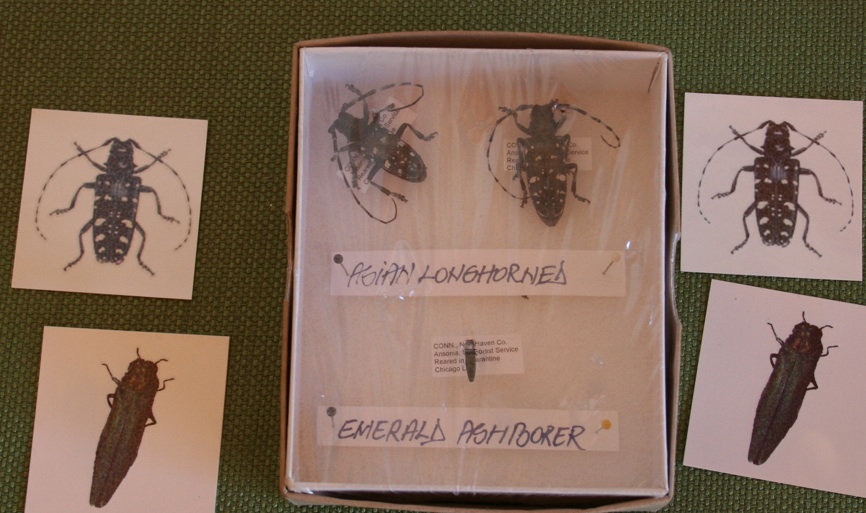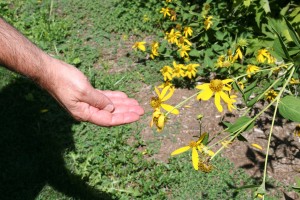His Work A World Legacy: Dr. Louis Magnarelli
It is with great sadness that we mark the passing of Dr. Louis A. Magnarelli, director of The Connecticut Agricultural Experiment Station, Thursday morning, July 11, 2013, at home after a courageous battle with illness. Lou’s career at the station began nearly four decades ago and he was the director of the institution for the last 9 years.
Dr. Magnarelli was known internationally for his work on ticks, tick-associated diseases, serological testing for vector-borne pathogens, and many other scientific accomplishments, far too numerous to catalog here.
His contributions to Connecticut and science were extensive and appreciated.

We were honored to meet and work with Dr. Magnarelli (along with Dr. Sharon Douglas, head of the CAES Department of Plant Pathology & Ecology and plant pathologist, seen above) at several Ag Day at the Capitol events. During on-site interviews at CAES or on the telephone, Dr. Magnarelli was always gracious and a consummate professional with patience in answering every question.
Magnarelli, a Durham resident, served as chief entomologist and state entomologist from 1987 to 2004 and was appointed director in 2004. He earned his doctorate in 1975 from Cornell University and shared his wealth of knowledge in every way, including publishing hundreds of scientific articles.
To honor his work and passion for life and science, there is no better choice than to attend the annual Plant Science Day at Lockwood Farm, 890 Evergreen Ave., Hamden, Wednesday, Aug. 7, 10 a.m. to 4 p.m. Lectures and demonstrations, programs, exhibits and field experiments sponsored by The Connecticut Agricultural Experiment Station along with guest speaker is Michael McLaughlin, who will discuss national food safety. Rain or shine. Gates open at 9:30 am. Free.
For anyone who has not been to a program or event hosted by CAES, another choice is to encourage a young person interested or involved in science or agriculture.
From our archives from a story and interview and tour with Dr. Magnarelli:
“Right now there are two beetle species we're worried about. The Emerald ash borer and the Asian longhorn.”
“This is important to the economy of the state, but also for the diversity of forests. These two insects could change things. Woodpeckers do a pretty good job at getting these beetles, but there aren't enough of them. Both beetles have a high reproductive rate.”
With a main research campus in New Haven, the 75-acre research farm in Hamden, a 50-acre satellite research facility and farm in Windsor (Valley Laboratory), and a 26-acre prime farmland site in Griswold, the station itself was declared a National Historic Landmark in 1964.
“Agriculture is our backbone,” he said. “We're committed to farmers in Connecticut.”
“What's happened here in Connecticut and in many other areas of the country and even in Europe, is that about 200 years ago, we had predominately agricultural land with forest that had been cleared for farming. As small farms disappeared and large farms began commercially producing our food, the forests came back. With that came an increase in the white-tail deer, and an increase in ticks. White-footed mice enter the picture as reservoirs for these infectious agents. Combine those three elements and there is a build up of Lyme disease organisms in the environment. We did a lot of early work on the ecology of Lyme disease. In Connecticut and other areas of the northeast and the upper Midwest, there is a very high concentration of infection.”
Dr. John Anderson, a previous director, and Magnarelli started the tick research program back in 1977. From state (www.ct.gov) biographies page: Dr. Magnarelli’s research specialty is medical entomology and his expertise covers mosquitoes, ticks, Lyme disease, Rocky Mountain spotted fever, human and canine ehrlichiosis, anaplasmosis, babesiosis, tularemia, and serologic testing for antibodies to pathogens transmitted by ticks and mosquitoes. To improve laboratory diagnosis of tick-associated diseases, highly specific reagents are being produced by collaborating scientists at Yale University and the University of Texas (Houston) and are being tested at The Connecticut Agricultural Experiment Station to develop highly sensitive and specific assays for antibodies. Emphasis is also being placed on monitoring tick-borne infections and West Nile virus activity in horses, dogs, cats, cattle, and in wildlife (deer and rodents). Dr. Kirby Stafford, a medical-veterinary entomologist and chief scientist of the CAES Department of Entomology, researches the ecology and control of the tick that transmits the agents of Lyme disease, human babesiosis, and human ehrlichiosis. He also has expertise in the biological control of fly pests of livestock and poultry pest management.
That’s just a sample of the station’s ongoing mission in the state and across the nation connecting information with the world. For information and other public programs offered, visit www.ct.gov/caes.


